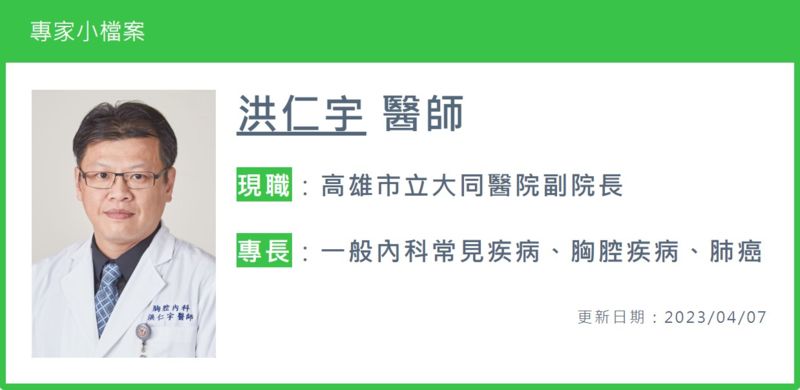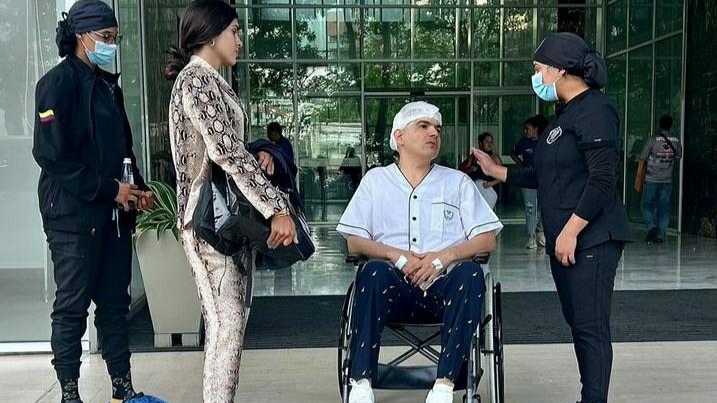Reported by Health and Medical Network/Reporter Zheng Yifen
Lung cancer has topped the top ten cancer mortality rates for consecutive years, among which small cell lung cancer is the most difficult type of lung cancer. Hong Renyu, deputy director of Kaohsiung Municipal Tatung Hospital, appealed that as various drugs and treatment methods continue to come out, patients can discuss with doctors the most suitable treatment strategy, which will help control the disease. In one case, after chemotherapy combined with immunotherapy, not only the survival period was greatly prolonged, but also the physical condition was stable, and he returned to his beloved workplace.
▲Due to the rapid growth of small cell lung cancer tumors, patients in the spreading stage are not suitable for radiation therapy. Dr. Hong Renyu said that the main treatment method is chemotherapy. If the patient’s physical strength can afford it, two chemotherapy drugs will be used in combination in the first-line treatment, 70-80% Patients’ tumors can effectively shrink. (Photo/Provided by Health and Medical Network)
Small cell lung cancer has a poor prognosis and a high chance of recurrence within 2 years
Small cell lung cancer is one of the four cell types of lung cancer (adenocarcinoma, squamous cell carcinoma, large cell carcinoma, small cell carcinoma). Although it accounts for less than 10% of all lung cancers, the growth rate of cancer cells is faster than other types of lung cancer. Fast, 60-70% of patients are already in the spreading stage when they are discovered, and have metastasized to the brain, bones and liver.
Due to the rapid growth of small cell lung cancer tumors, radiation therapy is not suitable for patients in the spreading stage. Dr. Hong Renyu said that the main treatment method is chemotherapy. If the patient’s physical strength can afford it, two chemotherapy drugs will be used in combination in the first-line treatment. 70-80% of patients tumors can be effectively shrunk.
However, small cell lung cancer responds well to chemotherapy, but the survival rate of patients is poor. Dr. Hong Renyu said frankly that the recurrence rate within 2 years is high, and many patients relapse within 3 months after stopping the drug. In the past, there were few types of drugs that could effectively treat small cell lung cancer. Even with second-line treatment, as many as 80% of patients still had unsatisfactory therapeutic effects or the drug effects could not last for too long, and the effect of subsequent drug changes was not good. For example, the relief pitcher is not strong enough, in this case, if the first-line drug for the starting pitcher can last longer, it will effectively prolong the time of disease control of the patient.”
Chemotherapy combined with immunization effectively prolongs disease control time
Are patients with small cell lung cancer hopeless once they enter the diffuse stage? Dr. Hong Renyu said that in addition to the use of chemotherapy drugs paid by health insurance, studies have confirmed that “immunotherapy combined with chemotherapy” can effectively prolong the time of disease control.
Traditional chemotherapy can inhibit the division of cancer cells, while the principle of immunotherapy is to stimulate the body’s immune system to attack cancer cells. According to the Taiwan Cancer Foundation, chemotherapy combined with immunotherapy “joint attack” can help improve the effect of cancer treatment. When chemotherapy causes cancer cells to wither, more tumor antigens are released during the lysis process, and then become immune cells to recognize cancer cells important information, making T cells more sensitive to the detection and elimination of cancer cells. With the use of immune checkpoint inhibitors, the occurrence of side effects must still be closely tracked. Under the regular monitoring of medical personnel, the safety of medication can be ensured and patients can be assured of treatment options.
Dr. Hong Renyu shared that during the consultation, an elderly male patient had a chronic cough and went to the hospital to take a chest X-ray suspected of having a tumor. The location and extent of the tumor were confirmed by computerized tomography scan, and further biopsy was performed to confirm the diagnosis of small cell lung cancer. After 6 courses of chemotherapy combined with immunotherapy, the patient was treated with immunotherapy alone. He has been under good control for nearly 2 years and has been able to resume his daily life. “I love to go to work, but I feel uncomfortable at home.”
No matter which type of lung cancer is diagnosed, patients should not give up treatment. Physician Hong Renyu appealed that lung cancer drugs have continued to have new developments over the years. Not only are there more and more targeted drugs that can precisely treat lung cancer with various gene mutations, but the combination of immunotherapy and chemotherapy can also effectively control the development of the disease. Physicians discuss the most suitable treatment strategies for themselves to prolong survival. It is hoped that more and more drugs will be developed in the future, which will be included in the health insurance benefits as soon as possible to reduce the burden on patients and their families.

▲ (Photo/Provided by Health and Medical Network)
source: healthnews.com.tw
healthnews.com.tw

